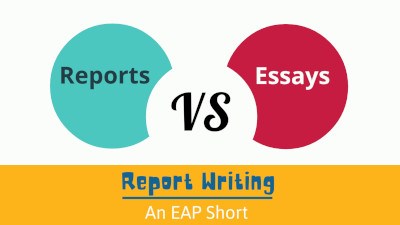Show AWL words on this page.
Show sorted lists of these words.


 







|
 Podcast is loading. Too slow? Click here to access.
Podcast is loading. Too slow? Click here to access.
There are many forms of writing which you may have to undertake at university, from reflective journals to extended researched assignments. The two most common forms of writing are reports and essays. This page describes what a report is, outlines the main types of report you may need to write, and summarises the differences between reports and essays.
What is a report?
A report is a clearly structured form of writing which presents and analyses information clearly and briefly for a particular audience. The information is usually the result of an experiment, investigation, or some other form of primary research such as a questionnaire or survey. It will contain headings and sub-headings, as well as graphics such as graphs, charts and tables. Reports often use the information they contain to present recommendations for future action. They are common not only at university, but also in industry and government. For more information on what a report is, see the section below which compares reports to essays.
Types of report
There are many different types of reports which can be written, though the type you will write at university depends very much on your course of study. Each report will have a different format and writing conventions, though the structure and language used are broadly similar for all reports. The following are some of the main reports written at university.
- Laboratory report. This type of report explains and analyses the results of an experiment. It may also be called lab report, experimental report, or science report.
- Business report. This analyses a situation and uses business theory to provide solutions or recommendations. It includes many types, e.g. market research report, marketing report, and financial report.
- Case study report. This examines a real-world situation (the 'case') and analyses it using appropriate theory (the 'study').
- project report. This reports on project work which has been conducted.
- Research report. This gives the results of research which has been conducted, for example through surveys (via questionnaires or interviews).
- progress report. This informs a supervisor about progress on a project over a certain period of time.
- Design report. This report describes and evaluates a design used to solve a particular problem.
- Field report. This combines theory and practice by describing an observed person, place or event and analysing the observation.
Other types of report are possible, such as a systems analysis report, a maths report, a feasibility study and a client case work report. Some disciplines, especially business, may require you to write an essay with headings. This is not a report, since all the other features, aside from the headings, are the same as a conventional essay.
Reports vs. essays
Although many of the writing skills required for essays also apply to reports, such as use of topic sentences, cohesion and citations, reports are quite unlike essays in several regards. The table below summarises the main differences. These are divided into three categories: general areas, structure, and content.
General: Purpose |
Report: Provides specific information (description and explanation) to the reader |
|
Essay: Presents an argument |
|
General: Readability |
Report: Allows information to be found quickly in specific sections (and the abstract) |
|
Essay: Requires careful reading to follow the argument |
|
General: Writing skills |
Report: Demonstrates research skills and ability to analyse information |
|
Essay: Demonstrates ability to support an argument (thesis) through knowledge and understanding of the topic |
|
General: Length |
Report: Will always be a long assignment |
|
Essay: May be relatively short (e.g. for an exam answer) or a long assignment |
|
Structure: Sections |
Report: Has clearly defined sections, each with a different function |
|
Essay: Uses well ordered paragraphs, not sections |
|
Structure: Headings |
Report: Uses headings and sub-headings for the different sections (often numbered) |
|
Essay: Does not usually use headings, sub-headings or numbering |
|
Structure: Contents page |
Report: Will often include a Contents page to show the sections of the report |
|
Essay: Will not usually include a Contents page |
|
Content: Graphics |
Report: Usually uses graphics such as tables, graphs, charts |
Essay: Does not usually include graphics |
|
Content: Research |
Report: Usually includes primary research (e.g. experiment, survey) in addition to secondary research |
|
Essay: Generally only includes secondary research (e.g. citations from text books/journals) |
|
Content: Recommend-ations |
Report: Often has recommendations |
|
Essay: Only certain essay types (e.g. discussion) include recommendations |
|
Content: Appendices |
Report: May include appendices with additional information |
|
Essay: Unlikely to include appendices |
| Report | Essay |
||
| General | Purpose |
|
|
| Readability |
|
|
|
| Writing skills |
|
|
|
| Length |
|
|
|
| Structure | Sections |
|
|
| Headings |
|
|
|
| Contents page |
|
|
|
| Content | Graphics |
|
|
| Research |
|
|
|
| Recommend-ations |
|
|
|
| Appendices |
|
|
References
Charles Darwin University (2013) Report. Available from http://learnline.cdu.edu.au/studyskills/studyskills/reports.html (Access date 19 July, 2015).
Massey University (2012) Business Report. Available from http://owll.massey.ac.nz/assignment-types/business-report.php (Access date 20 July, 2015).
Monash University (2015) Report Writing. Available from http://www.monash.edu.au/lls/llonline/writing/general/report/index.xml (Access date 20 July, 2015).
Purdue University (2015) Purposes and Types of Report Format. Available from https://owl.english.purdue.edu/owl/resource/726/02/ (Access date 20 July, 2015).
Queensland University of Technology (2014) Writing a report Available from http://www.citewrite.qut.edu.au/write/report.jsp (Access date 19 July, 2015).
RMIT University (2007) Differences between Essays, Reports and Journals. Available from https://www.dlsweb.rmit.edu.au/lsu/content/2_assessmenttasks/assess_pdf/diffbet_reportsessays.pdf (Access date 19 July, 2015).
Unilearning (2000) Comparison: reports and essays. Available from http://unilearning.uow.edu.au/report/1b.html (Access date 19 July, 2015).
University of Queensland (2015) Types of assignment. Available from http://www.uq.edu.au/student-services/learning/types-of-assignments (Access date 20 July, 2015).
Next section
Find out about report structure in the next section.
Previous section
Read the previous article about the writing process.






